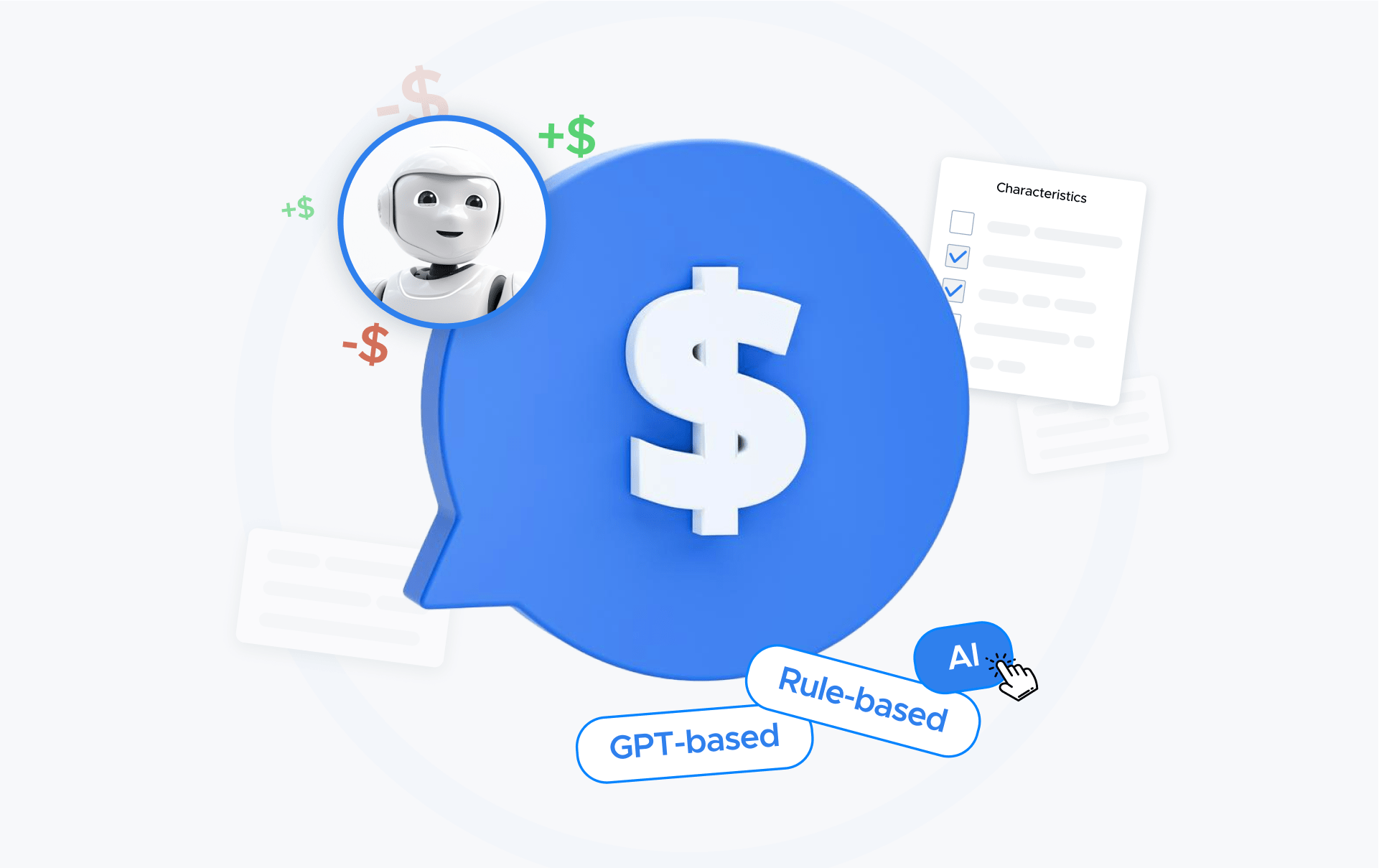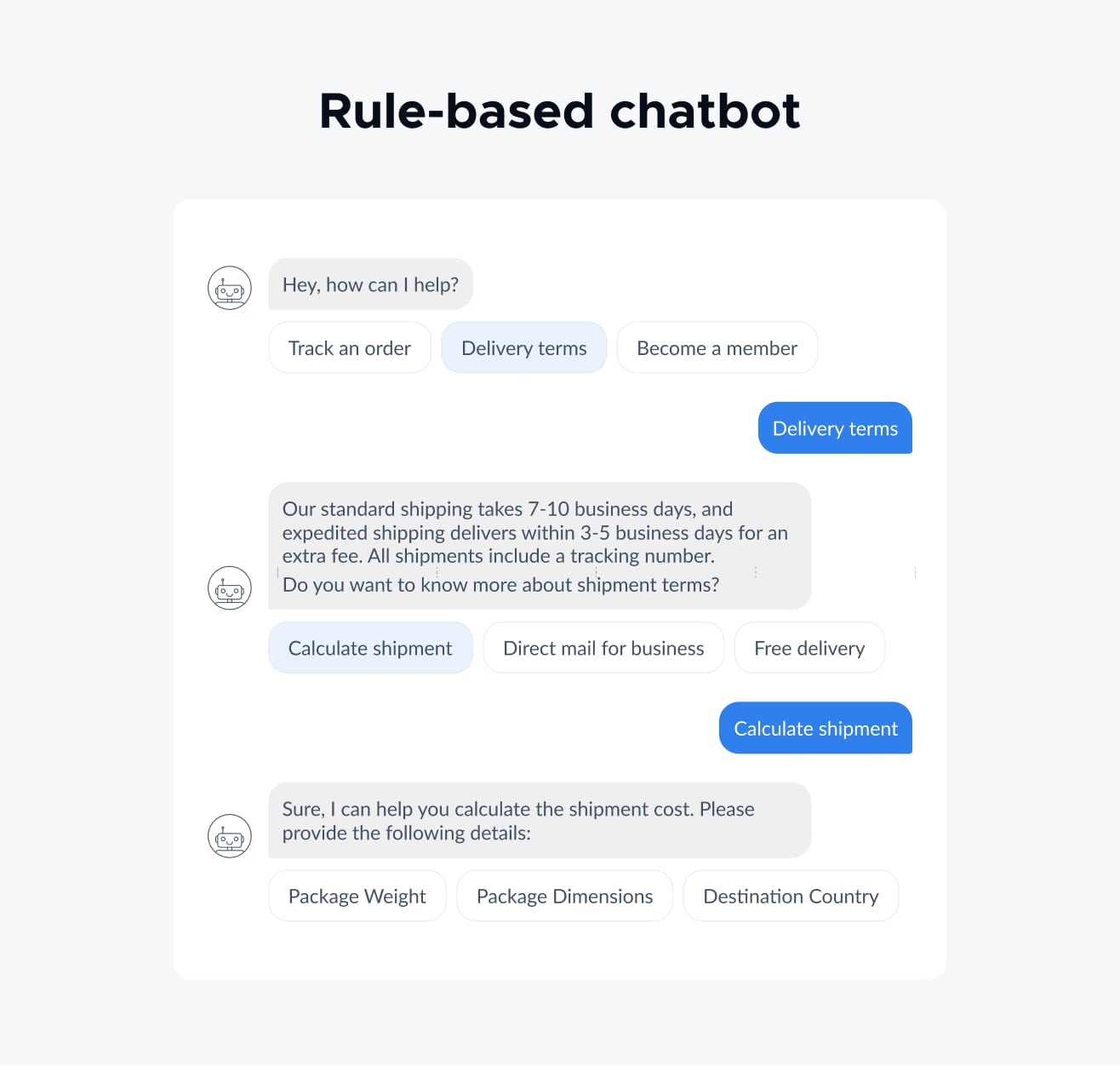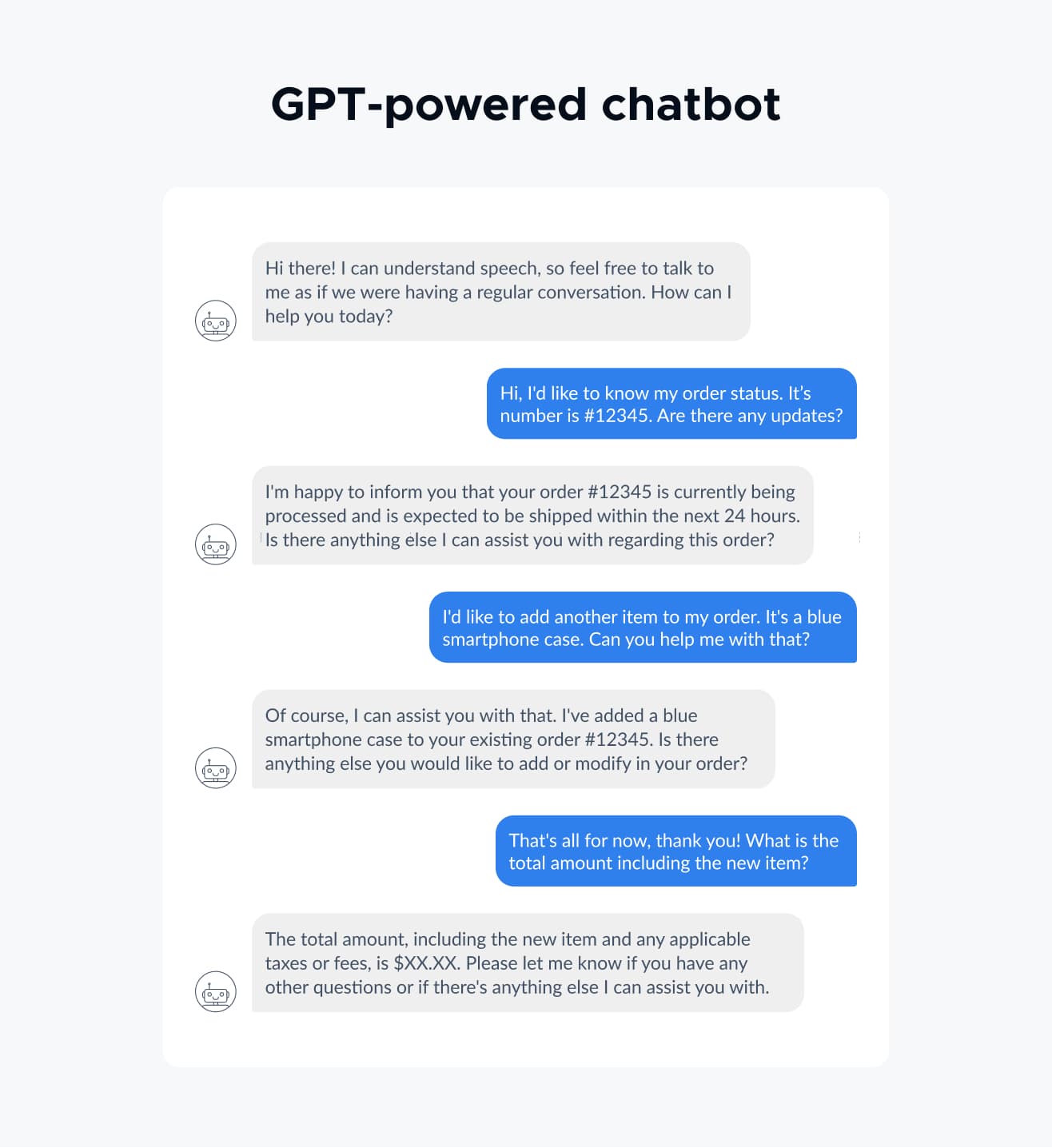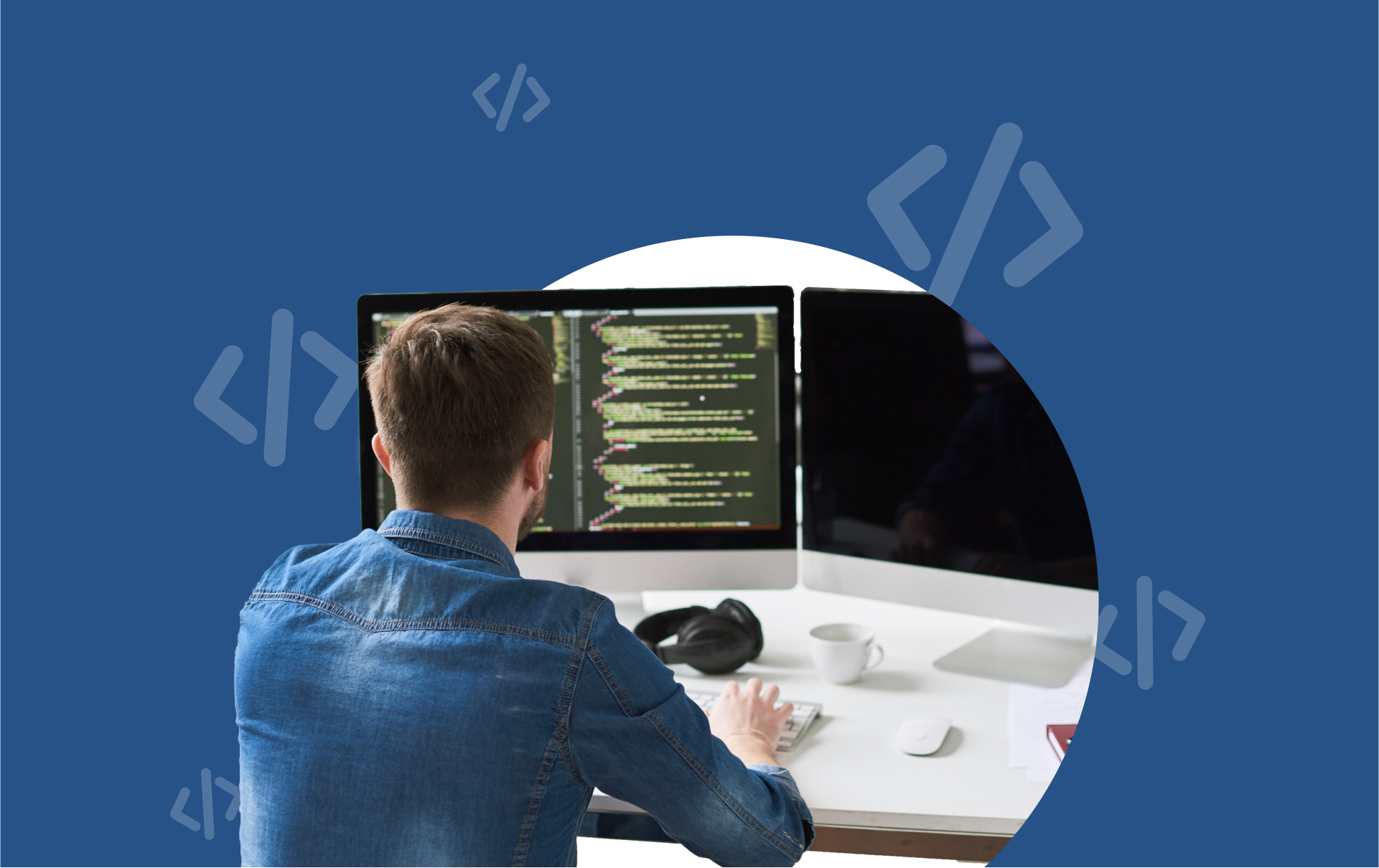Chatbot Pricing Guide: How Much Does a Chatbot Cost?
How much does a chatbot cost? Let's discover the main chatbot pricing factors influencing the chatbot’s cost and get insights into the budgeting and pricing models of chatbots.

Chatbots have become essential to modern businesses, streamlining communication and improving customer experiences. But when it comes to pricing, things can get a little tricky.
In this article, we'll break down chatbot pricing to help you make informed choices and find the perfect solution for your needs.
But first, let us give you a short answer.
How much does a chatbot cost?
Great question!
But, sadly, there is no unified answer to this question.
Before GPT and Generative AI, chatbot companies typically charged for chatbot development from $5,000 up to $200,000. With the rise of GenAI, the pricing models for chatbot development shifted. The reason is that if you want a simple prompt-based GPT-4 chatbot without extra integrations, features, etc., it can take less time to develop and cost less money. For example, a plain GPT-powered chatbot can cost from $2,000. Consider that, most likely, you’ll need some integrations like CRM, calendars, payments, etc, so it will add to your final cheque.
This is a very rough estimate that probably doesn’t fully answer your question. If you want to understand the potential cost of your chatbot better, continue reading our article, and we’ll try to simplify the complex process of forming a chatbot price for you.
How much can a chatbot return? Learn the potential customer service savings for free in a few clicks.
Development options
The most critical factor influencing a chatbot's cost is the type of development you choose.
There are 3 main development journeys you can choose from:
- Freelance chatbot developer
- Chatbot platform
- Chatbot agency
Factors Influencing Chatbot Pricing
Let’s look closely at different factors influencing chatbot pricing.
A. Type of the chatbot
Rule-based or Button-based chatbot
Rule-based chatbots function based on pre-established rules and patterns, following strict if-then statements or decision trees to determine how to respond to user inputs.
One benefit of rule-based chatbots is their simplicity and the direct control they offer over the conversation. Developers have complete authority over the rules, ensuring the chatbot responds appropriately to specific inputs. However, they may struggle to handle intricate or unforeseen user inputs, as predetermined patterns limit their responses.
Rule-based chatbots are well-suited for scenarios with clearly defined conversation flows and a limited range of potential user intentions. They are a solid starting point for creating fundamental chatbot functionality, such as FAQ chatbots.
Cost:
Naturally, the button-based bot would cost less than the AI-powered one. Usually, simple button-based chatbots cost 2-3 times less than AI-powered chatbots with NLP. The button-based bot could cost from $5,000-75,000.

AI-powered chatbot
AI-powered chatbots deliver more sophisticated and intelligent conversational interactions than rule-based or scripted ones. They understand the natural human language and can learn as more and more users communicate with it.
AI-powered chatbots use NLP (natural language processing) to understand human language. They can “remember" some user preferences or perform actions that are a little bit more complex. Integrating AI technologies empowers these chatbots to learn, enhance, and adapt to user requirements, resulting in more effective and lifelike interactions.
Cost:
These chatbots are more expensive than rule-based. An AI-powered chatbot with NLP abilities could cost between $10,000- 150,000.

GPT-powered chatbot
Generative chatbots are often powered by models like GPT (Generative Pre-trained Transformer). GPT is a specific type of generative model that has gained significant attention in natural language processing (NLP) and conversational AI.
Generative chatbots powered by GPT models can produce contextually relevant and coherent responses based on the input they receive. These models can generate human-like conversations, understand the context of the conversation, and provide detailed and contextually appropriate answers.
Cost:
These chatbots could cost between $2,000 to $150,000.

B. Integrations
Chatbot’s price can also be influenced by the number and type of integrations you want.
For example, payment systems, maps, scheduling, CRM, etc. This could even be custom integrations with your internal tools, platforms, apps, etc.
If you are building a chatbot using chatbot platforms, it might already have many integrations pre-build and out-of-the-box. But if we are talking about custom chatbot development, the formula here is quite simple: the more integrations you need, the more the chatbot will cost you.
Cost:
Estimated prices for integrations can vary from $1,000 to $10,000 per integration. The price depends on the complexity of logic that needs to be built to integrate this tool or system with the chatbot.
C. Languages
The pricing for languages is similar to integrations.
The more languages you need, the more you’ll need to pay.
Some platforms have many languages supported from the start, so adding additional languages to the bot will cost you less or nothing at all. However, some platforms and companies don't have built-in support for all languages.
Cost:
Prices for additional languages can start from $1,000/language and more.
D. Chatbot complexity
1. Complexity of coding and design
Chatbot’s price also highly depends on your requirements and the features you want to implement. Some of the features are easy to develop, and some take time. It’s better to consult someone with technical expertise in chatbots to understand which requirements are more complex.
Also, you need to consider the chatbot's personality and design. Chatbots with complex personas take more time for conversational designers to create and bring to life, so you’ll have to pay more for the designer's time.
2. Time invested in training the chatbot
There is a very simple logic with chatbot training - the more data you want the chatbot to know, the more time it will take to train and test it.
Tip: When you have a lot of data, prioritizing and dividing is the smartest and most cost-effective approach to chatbot training. You need to understand which data is essential and needs to be in the first version of the chatbot and which data can be added later in the following versions.
Common Chatbot Pricing Models

Avoiding Common Pitfalls in Chatbot Pricing
A. Overpaying for Unnecessary Features
Identifying the core functionalities essential to achieving your business objectives is crucial when developing or investing in a chatbot. These essential features form the backbone of the chatbot and directly influence its cost.
On the other hand, optional features are additional functionalities that may enhance the user experience or cater to specific needs but are not fundamental to the bot's core functionality. Incorporating optional features can add to the development complexity and, consequently, the overall cost.
By carefully evaluating which features are essential and which are optional, businesses can optimize their chatbot investment, ensuring they get the necessary functionalities without overspending on non-essential extras. A well-balanced approach to feature selection is key to maximizing value and achieving the desired results from a chatbot while managing costs effectively.
B. Ignoring Hidden Costs
In chatbot development, it is essential to identify potential additional costs that may arise beyond the base pricing. While the initial development cost may cover the core functionalities of the chatbot, various factors can lead to supplementary expenses.
For example, if you are building a WhatsApp chatbot or GPT-powered chatbot, you will have to pay for WhatsApp and OpenAI additionally. The other example is hosting. Hosting the chatbot on servers incurs ongoing expenses, especially if the bot experiences significant traffic.
In conclusion
In conclusion, navigating the landscape of chatbot pricing can be complex, with multiple factors influencing the total cost. The price of a chatbot can range from 2,000 to 200,000, depending on the type of development, complexity of features, integrations, languages, development time and effort, scalability, and maintenance. It is essential to carefully evaluate your requirements, understand the potential hidden costs, and avoid overpaying for unnecessary features. With a clear understanding of chatbot pricing models and cost factors, you can make informed decisions that align with your business goals and budget. Remember, a well-constructed chatbot can be a valuable investment, delivering significant returns in terms of improved customer experience and operational efficiency.
Looking for a personalized chatbot quote?
At BotsCrew, we understand that each business has unique needs and goals when it comes to implementing chatbots.
We're here to help you clarify your ideas, understand your requirements, and provide a personalized price for your chatbot that aligns with your budget.
Our team of experts will advise you on the best approach, the most suitable technologies, and the optimal budget allocation to ensure your chatbot delivers maximum value. Don't navigate the complexities of chatbot development alone. Contact us at BotsCrew today, and let's bring your chatbot vision to life.
How much can a chatbot return? Learn the potential customer service savings for free in a few clicks.









